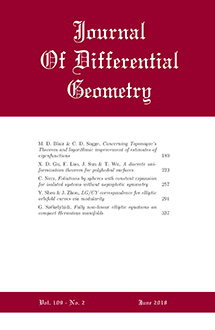Abstract
The main result of this paper is a construction of solutions to the reverse Yang–Mills–Higgs flow converging in the $C^{\infty}$ topology to a critical point. The construction uses only the complex gauge group action, which leads to an algebraic classification of the isomorphism classes of points in the unstable set of a critical point in terms of a filtration of the underlying Higgs bundle.
Analysing the compatibility this filtration with the canonical Harder–Narasimhan–Seshadri double filtration gives an algebraic criterion for two critical points to be connected by a flow line. As an application, we use this to construct Hecke modifications of Higgs bundles via the Yang–Mills–Higgs flow. When the Higgs field is zero (corresponding to the Yang–Mills flow), this criterion has a geometric interpretation in terms of secant varieties of the projectivisation of the underlying bundle inside the unstable manifold of a critical point, which gives a precise description of broken and unbroken flow lines connecting two critical points. For non-zero Higgs field, at generic critical points the analogous interpretation involves the secant varieties of the spectral curve of the Higgs bundle.
Funding Statement
This research was supported by Singapore Ministry of Education Academic Research Fund Tier 1 grant number R-146-000-200-112. The author also acknowledges support from NSF grants DMS 1107452, 1107263, 1107367 “RNMS GEometric structures And Representation varieties” (the GEAR Network).
Citation
Graeme Wilkin. "The reverse Yang–Mills–Higgs flow in a neighbourhood of a critical point." J. Differential Geom. 115 (1) 111 - 174, May 2020. https://doi.org/10.4310/jdg/1586224842





